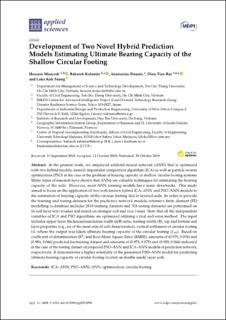| dc.description.abstract | In the present work, we employed artificial neural network (ANN) that is optimized with two hybrid models, namely imperialist competition algorithm (ICA) as well as particle swarm optimization (PSO) in the case of the problem of bearing capacity of shallow circular footing systems. Many types of research have shown that ANNs are valuable techniques for estimating the bearing capacity of the soils. However, most ANN training models have some drawbacks. This study aimed to focus on the application of two well-known hybrid ICA–ANN and PSO–ANN models to the estimation of bearing capacity of the circular footing lied in layered soils. In order to provide the training and testing datasets for the predictive network models, extensive finite element (FE) modelling (a database includes 2810 training datasets and 703 testing datasets) are performed on 16 soil layer sets (weaker soil rested on stronger soil and vice versa). Note that all the independent variables of ICA and PSO algorithms are optimized utilizing a trial and error method. The input includes upper layer thickness/foundation width (h/B) ratio, footing width (B), top and bottom soil layer properties (e.g., six of the most critical soil characteristics), vertical settlement of circular footing (s), where the output was taken ultimate bearing capacity of the circular footing (Fult). Based on coefficient of determination (R2) and Root Mean Square Error (RMSE), amounts of (0.979, 0.076) and (0.984, 0.066) predicted for training dataset and amounts of (0.978, 0.075) and (0.983, 0.066) indicated in the case of the testing dataset of proposed PSO–ANN and ICA–ANN models of prediction network, respectively. It demonstrates a higher reliability of the presented PSO–ANN model for predicting ultimate bearing capacity of circular footing located on double sandy layer soils | en_US |

